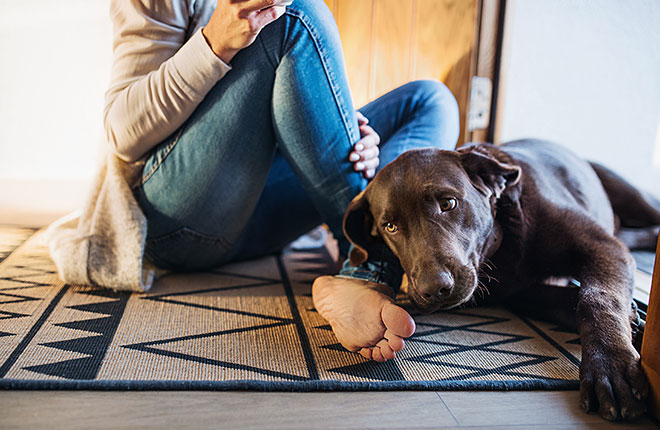No one knows your dog better than you. Because of this, you’re likely the first person to notice changes in your dog’s behavior, such as those that occur when a dog develops osteoarthritis. Nearly 40% of all dogs show signs of OA pain, yet almost 50% remain undiagnosed1,6. Dogs of all ages, breeds, and sizes can be diagnosed with OA2.
If your veterinarian does diagnose osteoarthritis in your dog, you’ll be the first to notice how well their OA pain management approach is working. This is important for you to pay attention to because osteoarthritis pain that is undertreated will worsen over time.

Tracking Pain Progression Through Observations
If you see your dog limping or walking slower than normal, you might just think it’s a sign they’re getting older. But what if it’s more than that? Approximately 75% of pet owners attribute changes in their dog’s behavior to aging when, in reality, they could be suffering from OA pain7.
Look out for the signs that your dog is in pain. Hint: they’re not all physical.
- Limping
- Hesitation to jump (like into/out of car, or onto/off of bed)
- Slow to rise after sleeping or laying down
- Changes in happiness levels
- Decreased energy
- Not as interactive with you
- Constantly licking at (arthritic) joints
If your dog is showing any of these signs or acting out of the ordinary, it’s worth a trip to your veterinarian. Use this OA quiz to see if your dog is showing signs of osteoarthritis-related pain and email them directly to your veterinarian or take the results with you to your dog’s next vet appointment.
If your dog is diagnosed with osteoarthritis, your veterinarian will likely prescribe a pain medication, such as a non-steroidal anti-inflammatory drug (NSAID) or a once-a-month injection option. Good news: it’s very common for dogs to be much more active and return to their old selves when their pain medication kicks in.
Video is also an effective tracking tool. If there isn’t a difference, talk to your veterinarian. You may need to wait longer to see a significant improvement or adjust the protocol to best manage your dog’s pain level. The checklist will help you track your dog’s progress over time.
Don't be fooled into stopping treatment because your dog’s behavior plateaus. Always speak with your veterinarian before changing your dog’s treatment plan.
Why Tracking Your Dog’s Pain Matters
Osteoarthritis is progressive in both humans and dogs. This means that without proper pain management, your dog’s pain will likely get worse over time and be felt in areas other than their arthritic joints3. The things that were once a walk in the park — both literally and figuratively — may now be very painful. Even a gentle act like petting their back can make them flinch or cry because it hurts.
Pain management is essential to prevent or lessen your arthritic dog’s discomfort and improve their overall quality of life4. Not following your veterinarian’s dosing instructions gives pain the opportunity to worsen over time.
Important caution: Because dogs handle (metabolize) medications differently than people do, don’t give your dog any human medications without first speaking with your vet5. Some aren’t effective in dogs, and others are downright dangerous for them. And this is true whether your medications are prescription or over-the-counter.
How To Tell if Your Dog’s Pain Is Returning
Because osteoarthritis pain often progresses gradually over time, it may be difficult to notice that the pain has come back. You can use the OA symptom checklist to assess their symptoms regularly so you and your veterinary team have a tool to help ensure your dog is as comfortable as possible.
Pro Tip: There are wearable smart collars for your pet that measure, amongst other things, their heart rate, respiratory rate, and even activity level. The collar can even alert you to concerning changes. Ask your vet if this would be a good option for your dog.
If you have an arthritic dog, learn how you can make changes around your home to make their life more comfortable.
ZPC-00281R2
IMPORTANT SAFETY INFORMATION: Librela is for use in dogs only. Women who are pregnant, trying to conceive or breastfeeding should take extreme care to avoid self-injection. Hypersensitivity reactions, including anaphylaxis, could potentially occur with self-injection. Librela should not be used in breeding, pregnant, or lactating dogs. Librela should not be administered to dogs with known hypersensitivity to bedinvetmab. Adverse events reported post-approval include ataxia (lack of balance/coordination), anorexia (loss of appetite), lethargy (tiredness), emesis (vomiting), and polydipsia (increased drinking). The most common adverse events reported in a clinical study were urinary tract infections, bacterial skin infections and dermatitis (skin irritation/inflammation). See full Prescribing Information.
See the Client Information Sheet for more information about Librela.
- Wright A, Amodie DM, Cernicchiaro N, et al. Identification of canine osteoarthritis using an owner-reported questionnaire and treatment monitoring using functional mobility tests. J Small Anim Pract. 2022;63(8):609-618. doi:10.1111/jsap.13500
- Mele E. Epidemiology of osteoarthritis. Veterinary Focus.2007;17(3):4-10.
- Knazovicky D, Hegelson E, Case B et al. (2016). Widespread somatosensory sensitivity in naturally occurring canine model of osteoarthritis. Pain. 157(6):1325-1332.
- Reid J, Wright A, Gober M, Nolan, A.M, et al. (2018). Measuring chronic pain in osteoarthritic dogs treated long-term with carprofen, through its impact on health-related quality of life (HRQL). Vet Comp Orthop Traumato. 31(S 01): A1-A6. https://onlinelibrary.wiley.com/doi/full/10.1111/jsap.13500
- Get the Facts about Pain Relievers for Pets. FDA. https://www.fda.gov/AnimalVeterinary/ResourcesforYou/AnimalHealthLiteracy/ucm392732.htm.
- ZMR: 2023 OA Landscape Wave 6 Analysis: Quantitative Results. Zoetis Inc; June 2023.
- ZMR: Forward Group Canine Osteoarthritis Report Wave 3. Zoetis Inc; May 21, 2025.




